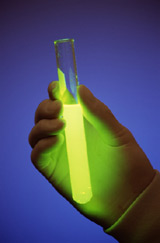Molecules go with the glow
A molecule-based information technology could use light, rather than electricity, for digital communication and data processing. The possibilities are enhanced by the demonstration of multichannel optical communication between different types of molecules in solution.
4 April 2002
Philip Ball
|
Shrinking information technology to the nanometre scale is one of the most demanding challenges facing the electronic engineer in the next decade or so. Françisco Raymo, a chemist at the University of Miami, believes that the answer may be to abandon conventional methods of synthesizing devices and start making them from individual molecules instead1. As an indication of what is possible, he and colleague Silvia Giordani have created a system in which digital information is passed optically between a set of molecules along three independent channels2.
In essence, this molecular system mimics the way in which optical data can be routed along conventional fibre-optic networks using wavelength-coding to transmit numerous different information streams in parallel. This multimode transmission is one of the great advantages of optical over electronic communications: it is much more difficult to send several simultaneous electronic signals as superimposed pulse streams.
The rudimentary prototype of Raymo and Giordani is hardly microscopic, but the optical signals both originate from, and undergo processing by, individual fluorescent molecules — so in principle the entire system should be workable at the molecular scale. If this could be achieved, single molecules could replace the microscale lasers, photodetectors, transistors and other components of today's optoelectronics communication circuits. As Raymo says, molecules "are synthesized in massively parallel processes in which billions of them are produced simultaneously. They are relatively cheap to make even in large quantities."
Single-molecule electronics, in which molecules act as wires and switches in circuits, has already been demonstrated in a rough-and-ready manner — for example, using carbon nanotubes. But Raymo thinks that processing digital information optically — molecular photonics — might have more attractions, such as obviating the need to interconvert optical and electronic signals in optoelectronic telecommunications. The downside is that it can be very hard to see how to 'wire up' individual molecules in a photonic circuit. Fluorescent molecules tend to glow isotropically: the light goes in all directions, making it hard to route information to particular destinations.
This remains true of the multichannel system devised by Raymo and Giordani, but it isn't a problem at the macroscopic scale at which they work. They use two cells containing solutions of the active molecules. Cell A contains molecules of three different organic compounds that fluoresce in response to optical stimuli from lasers. Cell B contains molecules of a compound that can be switched between three different light-absorbing states by three types of input: visible light, ultraviolet light, and protons (a chemical, rather than photonic, input).
The optical input to cell A determines which of the three molecules fluoresces and hence which of three possible wavelengths of light is emitted from the cell. The switching molecule in cell B may or may not absorb this light, depending on which of the three states it is in: that is, on the nature of the three inputs to cell B. So the light detected on the 'far' side of cell B depends on these three inputs for each of the three independent optical channels provided by the emitting molecules in cell A. The switchable molecule, in other words, enacts logic operations for three different data-transmission channels.
Raymo confesses that one of the big challenges to making this kind of system viable for information technology is "to incorporate these functional molecules into solid-state devices while maintaining their signal transduction abilities." Until that begins to look feasible, we had better keep relying on silicon.

